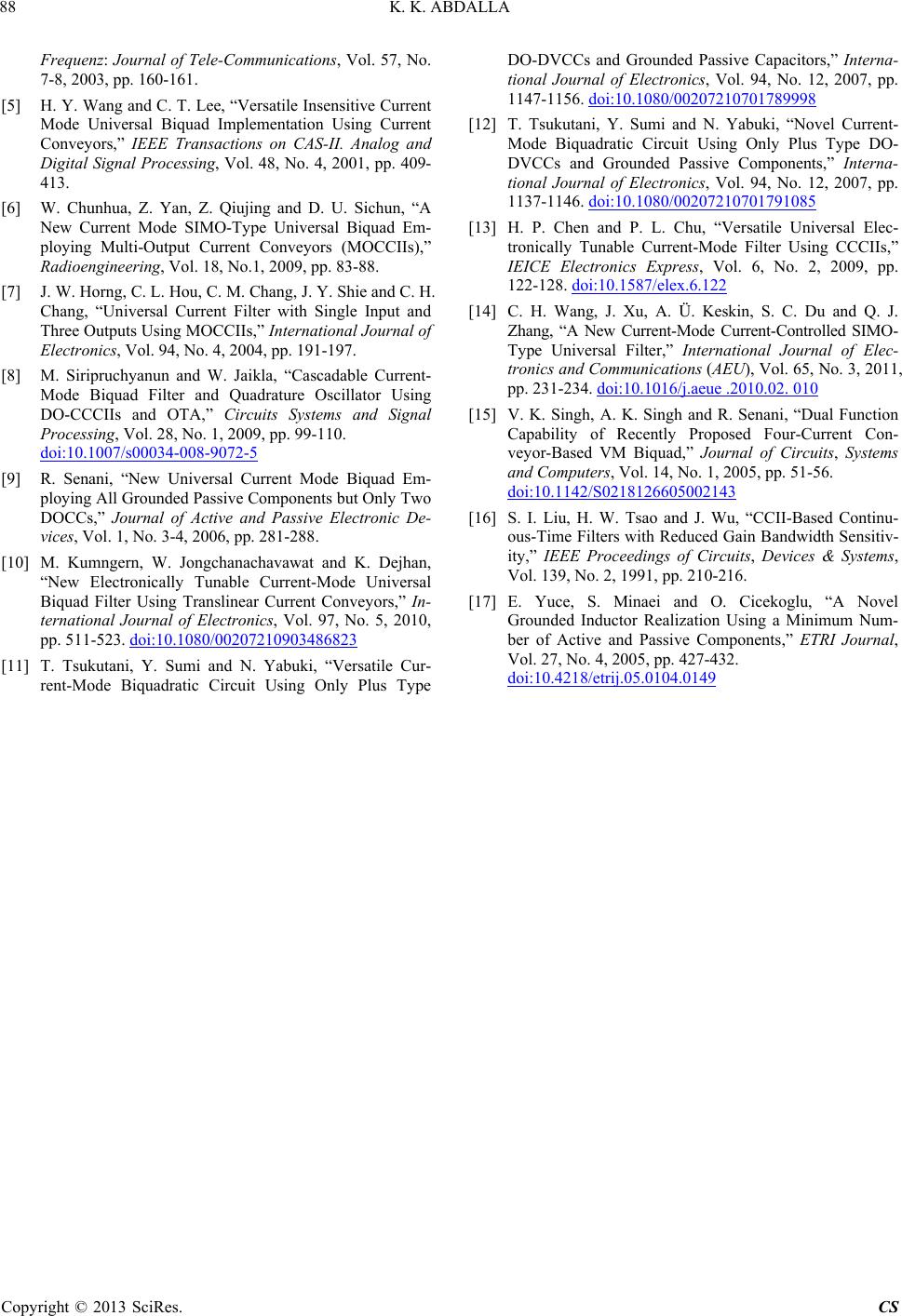
K. K. ABDALLA
Copyright © 2013 SciRes. CS
88
sactions on CAS-II. Analog and
g Multi-Output Current Conveyors (MOCCIIs),”
d Signal
Frequenz: Journal of Tele-Communications, Vol. 57, No.
7-8, 2003, pp. 160-161.
[5] H. Y. Wang and C. T. Lee, “Versatile Insensitive Current
Mode Universal Biquad Implementation Using Current
Conveyors,” IEEE Tran
Digital Signal Processing, Vol. 48, No. 4, 2001, pp. 409-
413.
[6] W. Chunhua, Z. Yan, Z. Qiujing and D. U. Sichun, “A
New Current Mode SIMO-Type Universal Biquad Em-
ployin
Radioengineering, Vol. 18, No.1, 2009, pp. 83-88.
[7] J. W. Horng, C. L. Hou, C. M. Chang, J. Y. Shie and C. H.
Chang, “Universal Current Filter with Single Input and
Three Outputs Using MOCCIIs,” International Journal of
Electronics, Vol. 94, No. 4, 2004, pp. 191-197.
[8] M. Siripruchyanun and W. Jaikla, “Cascadable Current-
Mode Biquad Filter and Quadrature Oscillator Using
DO-CCCIIs and OTA,” Circuits Systems an
Processing, Vol. 28, No. 1, 2009, pp. 99-110.
doi:10.1007/s00034-008-9072-5
[9] R. Senani, “New Universal Current Mode Biquad Em-
ploying All Grounded Passive Components but
DOCCs,” Journal of Active and Only Two
Passive Electronic De-
onveyors,” In-
vices, Vol. 1, No. 3-4, 2006, pp. 281-288.
[10] M. Kumngern, W. Jongchanachavawat and K. Dejhan,
“New Electronically Tunable Current-Mode Universal
Biquad Filter Using Translinear Current C
ternational Journal of Electronics, Vol. 97, No. 5, 2010,
pp. 511-523. doi:10.1080/00207210903486823
[11] T. Tsukutani, Y. Sumi and N. Yabuki, “Versatile Cur-
rent-Mode Biquadratic Circuit Using Only Plus Type
DO-DVCCs and Grounded Passive Capacitors,” Interna-
tional Journal of Electronics, Vol. 94, No. 12, 2007, pp.
1147-1156. doi:10.1080/00207210701789998
[12] T. Tsukutani, Y. Sumi and N. Yabuki, “Novel Current-
Mode Biquadratic Circuit Using Only Plus Type DO-
DVCCs and Grounded Passive Components,” Interna-
tional Journal of Electronics, Vol. 94, No. 12, 2007, pp.
1137-1146. doi:10.1080/00207210701791085
[13] H. P. Chen and P. L. Chu, “Versatile Universal Elec-
tronically Tunable Current-Mode Filter Using CCCIIs,”
IEICE Electronics Express, Vol. 6, No. 2, 2009, pp.
122-128. doi:10.1587/elex.6.122
[14] C. H. Wang, J. Xu, A. Ü. Keskin, S. C. Du and Q. J.
Zhang, “A New Current-Mode Current-Controlled SIMO-
Type Universal Filter,” International Journal of Elec-
tronics and Communications (AEU), Vol. 65, No. 3, 2011,
pp. 231-234. doi:10.1016/j.aeue .2010.02. 010
[15] V. K. Singh, A. K. Singh and R. Senani, “Dual Function
Capability of Recently Proposed Four-Current Con-
veyor-Based VM Biquad,” Journal of Circuits, Systems
and Computers, Vol. 14, No. 1, 2005, pp. 51-56.
doi:10.1142/S0218126605002143
[16] S. I. Liu, H. W. Tsao and J. Wu, “CCII-Based Continu-
cekoglu, “A Novel
ous-Time Filters with Reduced Gain Bandwidth Sensitiv-
ity,” IEEE Proceedings of Circuits, Devices & Systems,
Vol. 139, No. 2, 1991, pp. 210-216.
[17] E. Yuce, S. Minaei and O. Ci
Grounded Inductor Realization Using a Minimum Num-
ber of Active and Passive Components,” ETRI Journal,
Vol. 27, No. 4, 2005, pp. 427-432.
doi:10.4218/etrij.05.0104.0149